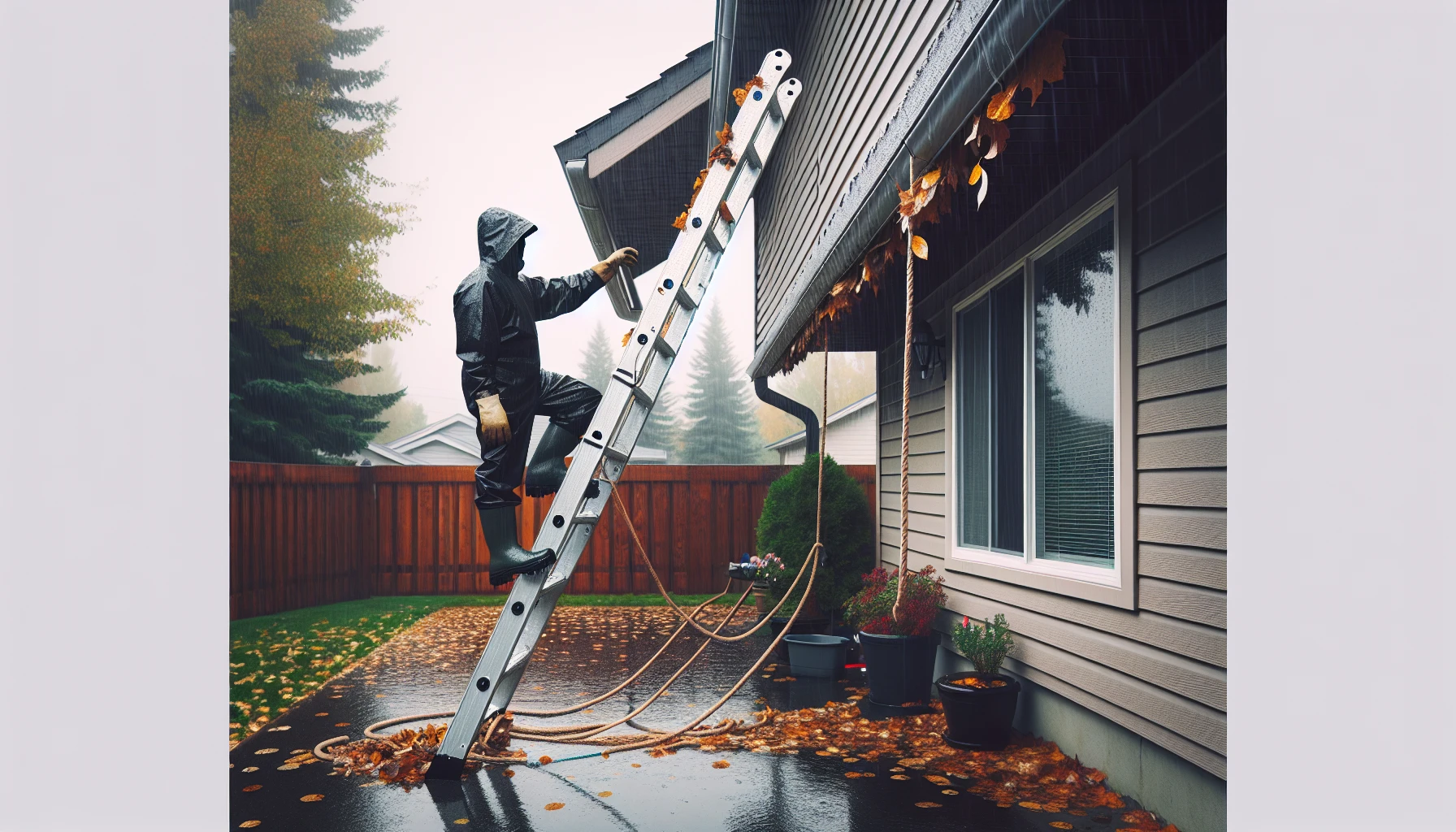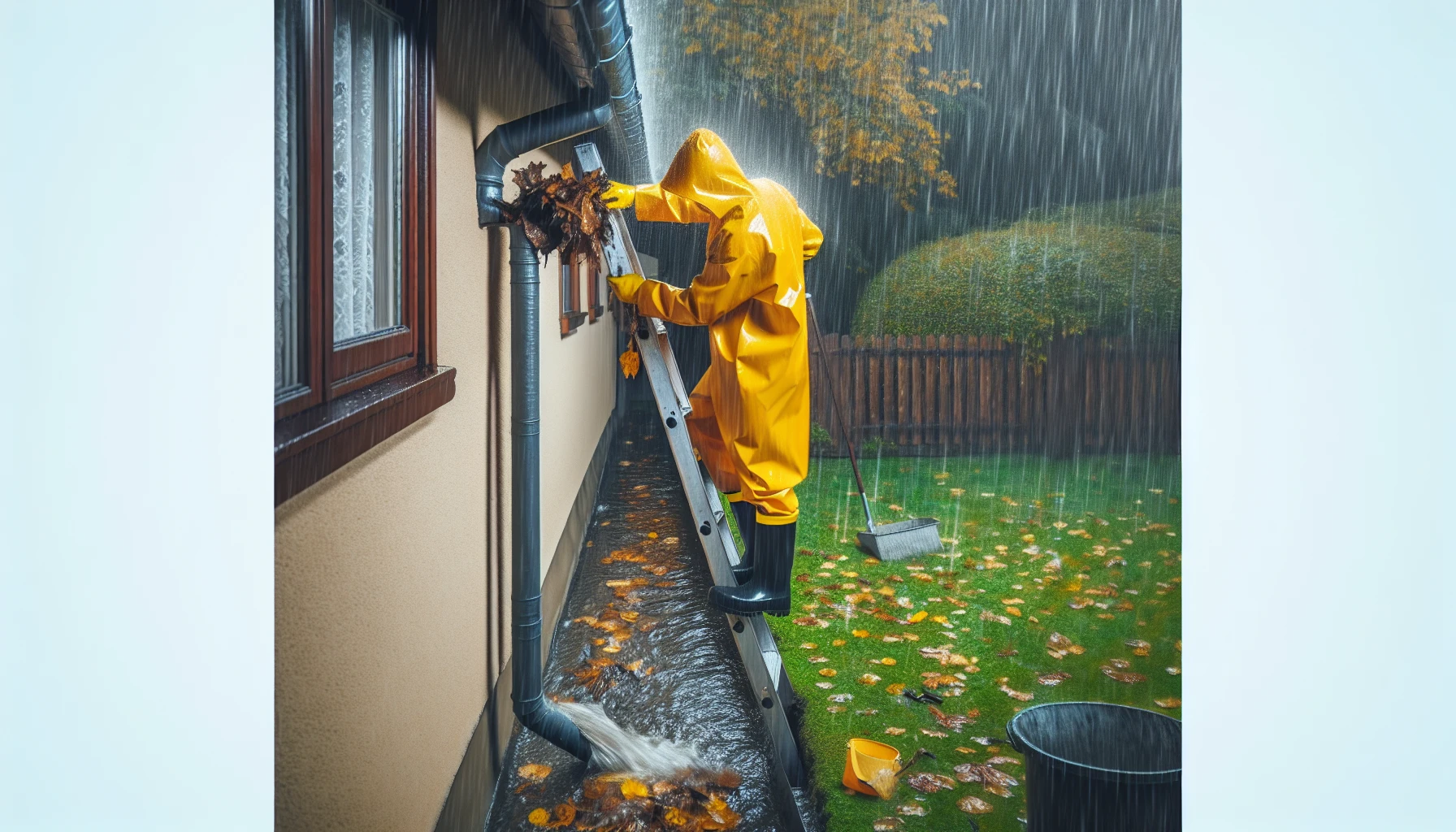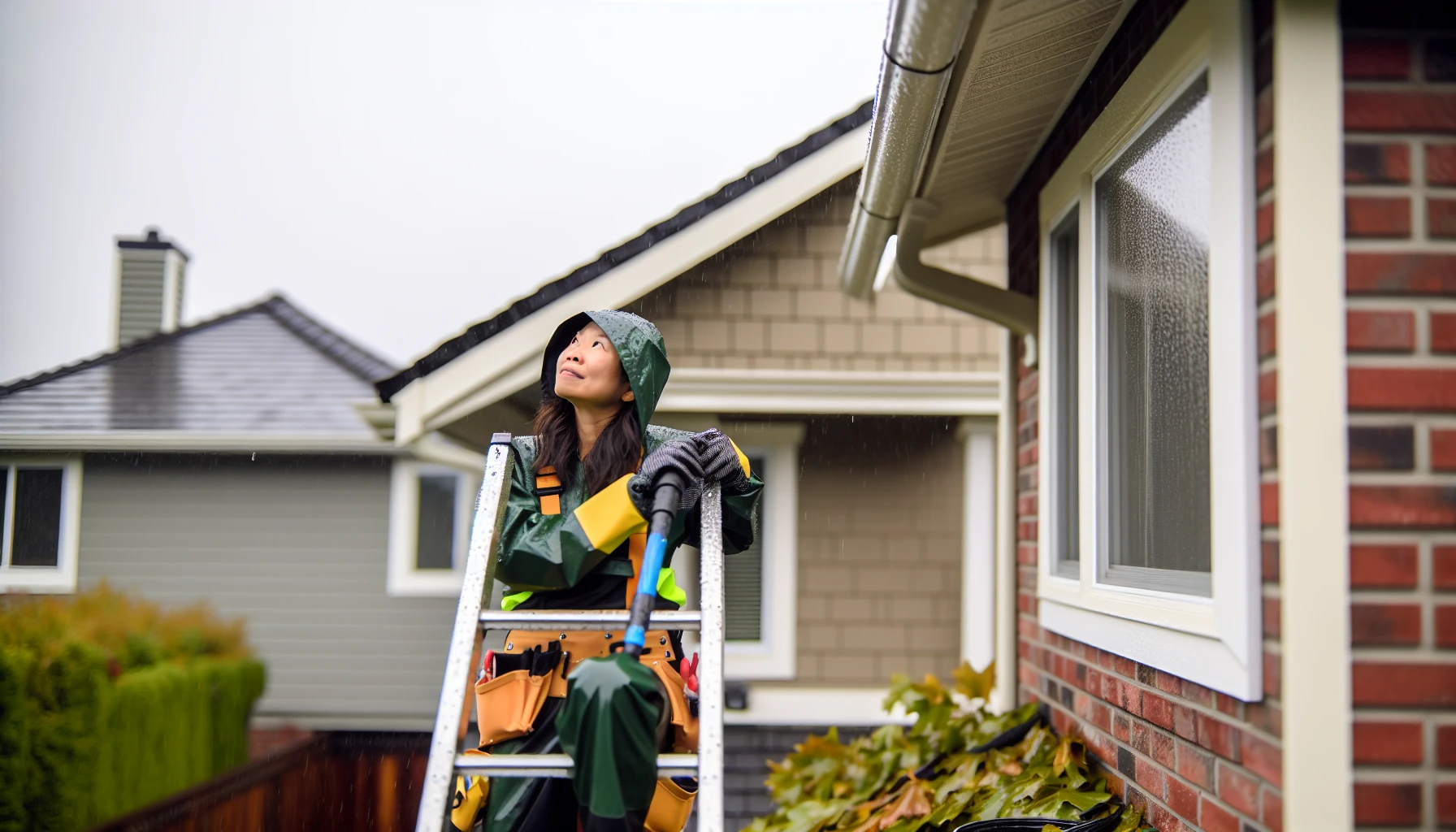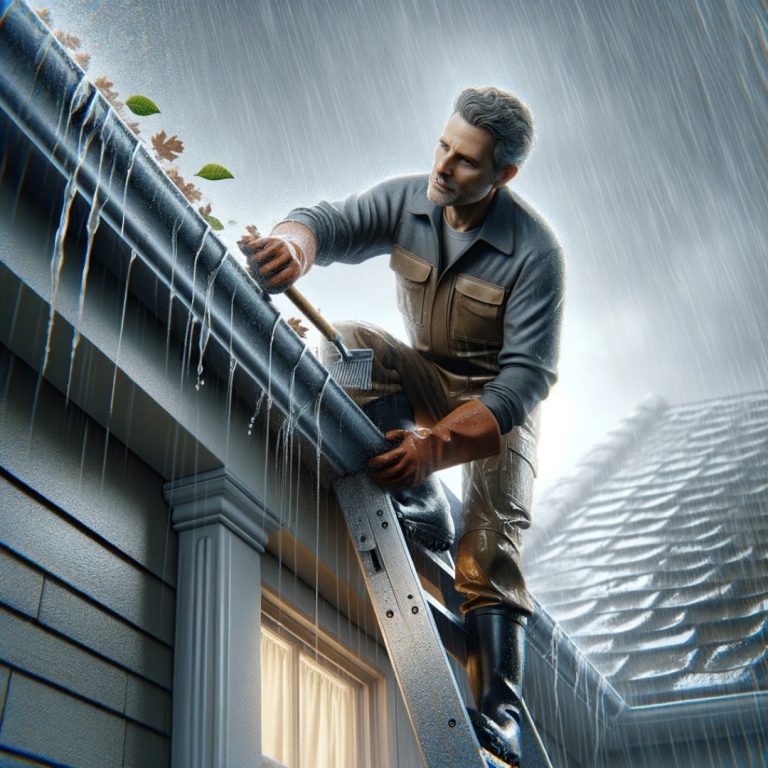Gutter cleaning is an essential task to maintain the integrity of your home. In the rain, it becomes even more critical, as clogged gutters can lead to water damage and other issues. However, cleaning gutters in the rain can be a daunting task, especially if you don’t know where to start. Worry not! We’re here to guide you through a step-by-step process that will ensure you clean your gutters safely and effectively amidst the drizzle.
In this blog post, we’ll explore when it’s advisable to clean gutters in the rain, how to properly prepare, the right tools to use, and how to clear gutters effectively during rainfall. We’ll also discuss post-rain gutter inspection, the benefits of installing gutter guards, and address safety concerns to ensure you can maintain your gutters with confidence and ease.
Key Takeaways
- Gutter cleaning in the rain is possible with light precipitation and appropriate safety precautions.
- Ensure a safe working environment by dressing appropriately, setting up a secure ladder, and having the right tools for efficient gutter maintenance.
- Address any potential hazards such as power lines or debris buildup to prevent water damage through post-rain inspection and installing gutter guards.
When is Gutter Cleaning in the Rain Advisable?

Cleaning gutters in the rain helps avoid damage from rainwater runoff due to clogged gutters and reduces the risk of rust corrosion. But when is it safe and advisable to clean them? Gutter cleaning in the rain is appropriate when the precipitation is light and not expected to become heavier, and when the roof gutters are free of any obstructions.
Before starting this task, assess the safety and advisability of the situation. Here are the steps to follow:
- Dress appropriately for the job.
- Secure the ladder.
- Use the right gutter scoop and a quality garden hose.
- Remove large debris first.
- Flush out fine particles.
- Inspect the gutters after the rain to check for any clogged gutters.
Preparing for Wet Weather Gutter Maintenance

To ensure safety and comfort while cleaning gutters in the rain, proper preparation is key. This involves dressing appropriately and securing your ladder for safety. By taking these precautions, you’ll be better equipped to handle the challenges that come with wet weather gutter maintenance.
Wearing protective gear is important when working on gutters. Make sure to wear:
- Thick work gloves
- A long-sleeve shirt
- Pants
- Safety glasses
- Nonslip boots or shoes
This will protect you from debris and sharp objects that may be in or around the gutter. Next, we’ll cover how to dress for the job and secure your ladder.
Dress Appropriately for the Job
When cleaning gutters in the rain, it’s essential to wear proper protective gear to ensure safety and comfort. A long-sleeve shirt, work pants, and rubber gloves are recommended for rainy conditions. Waterproof gloves are particularly beneficial, as they safeguard your hands from becoming wet.
Additionally, wear non slip shoes, like rubber boots, to provide protection against slipping on wet surfaces and insulation from electrical hazards while working in the gutter.
Secure Your Ladder
Using a stable extension ladder with stabilizers or a spotter is crucial for safety while working in wet conditions. A spotter can help ensure your safety on the sturdy ladder by bracing it from the ground and stabilizing it to prevent tipping over. They can also provide support and guidance while you clean the gutters, which is why it’s important to use a ladder frequently in such scenarios.
Remember, it’s not recommended for a child under the age of 16 to be a spotter when cleaning gutters on a ladder.
The Right Tools Make a Difference

Apart from dressing appropriately and securing your ladder, using the right tools can make gutter cleaning in the rain safer and more efficient. The right gutter scoop and a quality garden hose are key tools that can help you clean gutters effectively in wet conditions.
Selecting the right gutter scoop and garden hose will not only improve the safety of your gutter cleaning task, but it will also increase your efficiency and make it easier to remove debris from your gutters. In the following sections, we’ll discuss the features to look for in a gutter scoop and the benefits of using a high-quality garden hose during gutter cleaning.
Choose a Suitable Gutter Scoop
Selecting a suitable gutter scoop is crucial to effectively remove wet debris without causing damage to the gutters. A good gutter scoop should possess the following features:
- Protect your hands from scratches and dirt
- Effectively remove dead leaves, animal nests, and mud
- Be made of durable and waterproof materials
- Have a design that allows for easy maneuverability in wet conditions
- Fit well in the gutter to scoop out debris efficiently
Some of the most effective gutter scoop tools for wet debris removal include the Gutter Tool Gutter Cleaning Spoon and Scoop, the Gutter Getter Gutter Rake, and the Amerimax Home Products 8300 Getter Gutter Scoop.
Use a High-Quality Garden Hose
A high-quality garden hose with a nozzle attachment is an essential tool for gutter cleaning in the rain. It provides the required water pressure and reach to effectively clean the gutters. A garden hose suitable for gutter cleaning should possess qualities such as:
- Durability
- Flexibility
- Length
- Water pressure
- Nozzle attachment
- Leak-proofing
- Ease of storage
- Compatibility with relevant gutter cleaning attachments or tools.
Utilizing a nozzle attachment, such as a telescoping gutter cleaning wand, can help dislodge and remove dirt, leaves, and debris from the gutters, even in difficult-to-access areas.
Clearing Gutters Amidst the Drizzle

Once you’re dressed appropriately, your ladder is secure, and you have the right tools, it’s time to start clearing gutters amidst the drizzle. The key to successfully cleaning gutters in the rain is to remove large debris first, such as leaves and twigs, and then flush out fine particles with a hose.
Following this two-step process ensures that the gutters and downspouts are clear of debris, allowing water to flow freely and reducing the risk of water damage to your home.
In the next sections, we’ll discuss the techniques for removing large debris, flushing out fine particles, and handling the remaining debris.
Removing Large Debris First
Before flushing out fine particles, it’s important to start by removing large debris such as leaves and twigs to prevent clogs and make the flushing process more effective. You have 3 methods to choose from for gutter cleaning. Scoop and drop, using a plastic bucket, or bag can be used to scoop out the debris. Pick your preferred one and get ready to clean the gutters. Utilizing an effective gutter scoop tool, such as the Gutter Tool Gutter Cleaning Spoon and Scoop, can make the removal of large debris faster and easier.
Flushing Out Fine Particles
Once you remove the debris, use a hose to spray out any remaining particles and make sure the gutters are completely clean. This will not only help you clean your gutters more efficiently but also reduce the risk of clogs and water damage to your home.
When using a garden hose for gutter cleaning, follow these steps:
- Start at the end of the gutter furthest from the downspout opening.
- Work your way towards the downspout, running the water for several minutes.
- Check that the downspout is clear and no debris is present in the water.
Post-Rain Gutter Inspection
After the rain has stopped and you’ve cleaned your gutters, inspect them for any damage or leaks that may have occurred during the cleaning process. This step helps prolong your gutter system’s lifespan and prevent any problems that could result in expensive repairs or water damage to your home.
Look for key indicators of gutter damage, which could potentially lead to roof damage, such as:
- Water pouring out of gutters
- Water leaking into the basement
- Cracks in the foundation
- Standing water
- Bird’s nests and other pests in the gutters
- Overflowing water
- Sagging or warped gutters
- Lifted or degraded gutters
Addressing these issues promptly can save you time, money, and headaches in the long run.
Installing Gutter Guards as a Preventative Measure
One way to reduce the frequency of gutter cleaning in the rain and prevent debris buildup, including gutter gunk, is to install gutter guards. Gutter guards are designed to keep leaves, twigs, and other debris out of your gutters while allowing rainwater to flow through freely. By investing in gutter guards, you can save time and effort on gutter cleaning tasks and protect your home from potential water damage caused by a clogged gutter.
Various gutter guard options are available on the market, such as:
- Reverse-curve gutter guards
- Stainless steel mesh guards
- GutterBrush inserts
- Foam gutter guards
- Screen gutter guards
Before purchasing a gutter protection system, consider the manufacturer’s claims and the specific needs of your home’s gutter system to ensure you select the right product.
Addressing Safety Concerns

During the gutter cleaning process, prioritize safety. Wear suitable protective gear, use a stable ladder, and be mindful of power line hazards to ensure your safety while cleaning gutters in the rain.
Don’t forget to wear eye protection when using a garden hose to flush out debris, as this can help prevent potential eye injuries caused by debris being expelled from the downspout. If you notice any damaged power lines near your gutter system, contact a licensed professional electrical contractor to resolve the issue before proceeding with gutter cleaning.
Summary
In conclusion, gutter cleaning in the rain is a necessary task to maintain the integrity of your home and prevent potential water damage. By following the step-by-step process outlined in this blog post, you can safely and effectively clean your gutters in wet weather conditions.
Remember to dress appropriately, secure your ladder, use the right tools, remove large debris first, flush out fine particles, inspect your gutters after the rain, consider installing gutter guards, and address safety concerns. By taking these steps, you can maintain your gutters with confidence and ease, protecting your home and ensuring its longevity.
Frequently Asked Questions
What is the easiest way to clean rain gutters?
The easiest way to clean rain gutters is to use a leaf blower or an extension kit while on the roof. This eliminates the need for a ladder and scoop, as well as hours of tedious hand-removal of debris. Simply walk along the edge of the roof blowing leaves out of the gutter as you go.
Is it OK to have standing water in gutters?
It is not OK to have standing water in gutters, as it can lead to infestations, mold growth and rot. Mosquitoes, flies and other insects can also use the standing water to lay their eggs.
What happens if you don’t clean your rain gutters?
Failing to clean your rain gutters can lead to overflowing water, soaked shingles and damaged roofing, causing further leaking into your home. The weight of the rainwater can also tear down your gutter.
How do you clean the outside of gutters without a ladder?
You can clean the outside of your gutters from the ground without using a ladder by attaching a gutter-cleaning wand hose attachment to a garden hose, using a leaf blower gutter cleaning kit, clipping the debris out with gutter tongs, using a telescoping wand extension with a power washer, or hiring a professional gutter-cleaning service.
How do you unclog a gutter?
To unclog a gutter, use a metal hanger to create a hook and pull out the debris. Alternatively, you can use a power washer with a steady water supply to help dislodge the clog. Both methods should help restore the flow of water down the downspout.
